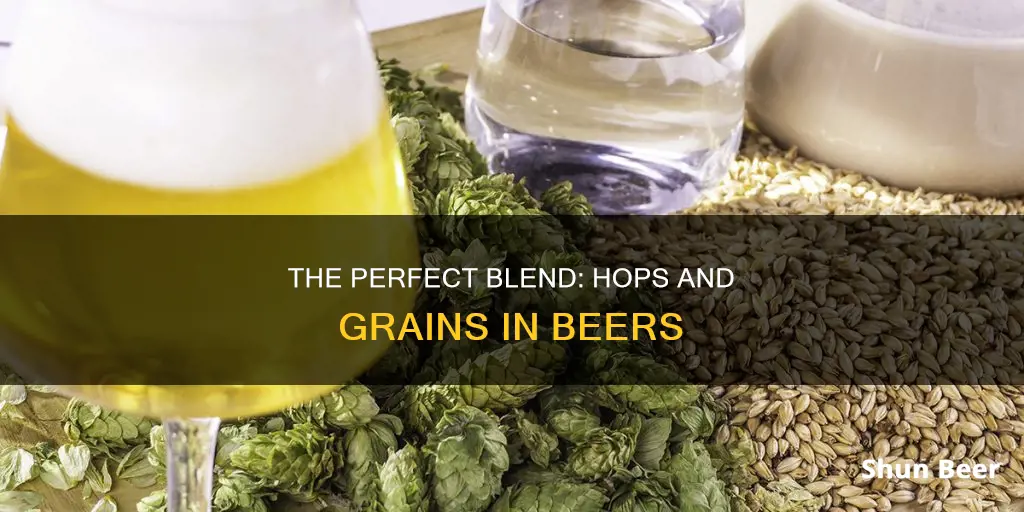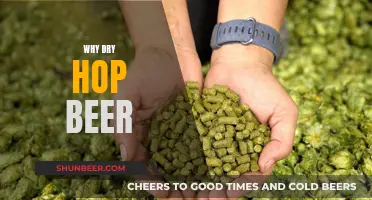
Beer is made from four primary ingredients: grains, hops, yeast, and water. The combination of these ingredients and the skill of the brewer makes every beer unique. Grains give beer its malt flavour and aroma, colour, and fermentable material for yeast to convert into alcohol. Hops are used to impart bitterness, flavour, and stability to beer, and they balance the sweetness of the malt. Hops also have antibacterial properties that help prevent spoilage.
Characteristics of Beers with Hops and Grains
| Characteristics | Values |
|---|---|
| Primary Ingredients | Grain, hops, yeast, and water |
| Grains | Barley, wheat, rice, corn, oats, and rye |
| Functions of Grains | Provide malt flavor and aroma, color, and sugar |
| Hops Functions | Impart bitterness, flavor, and stability |
| Hops Sources | Flowers of the female hop plant, Humulus lupulus |
| Hops Categories | Bittering, aroma, and dual-purpose |
What You'll Learn

Hops add bitterness, flavour and stability to beer
Hops are an essential ingredient in beer, adding bitterness, flavour, and stability.
Bitterness
The alpha and beta acids in hops are responsible for the bitter flavour of beer. Alpha acids, particularly humulone, are the main contributor to bitterness, while beta acids have a harsher bitterness but are less soluble, so their impact is lower. The longer the beer is fermented and aged, the more the beta acids oxidise and contribute to the bitterness.
Flavour
Hops also add flavour to beer. The essential oils in hops, such as myrcene, humulene, and caryophyllene, give beer its floral, citrusy, and hoppy aromas. Different varieties of hops have different levels of these oils, resulting in distinct flavours.
Stability
In addition to flavour and bitterness, hops also act as a preservative, extending the shelf life of beer. The antimicrobial properties of certain compounds in hops, such as iso-alpha-acids, inhibit the growth of certain bacteria. This helps to stabilise the beer and keep it fresh for longer.
The Brewing Process
The addition of hops during the brewing process is crucial to achieving the desired bitterness and flavour profile. Hops are typically added after the wort is transferred to the brew kettle and boiled, which sterilises the wort and extracts the bitter compounds from the hops. The boiling time can be adjusted to control the level of bitterness, with longer boil times resulting in more bitter beer.
Historical Use of Hops
Hops have been associated with brewing since the 8th century when they were first used in the Hallertau region of Germany. The use of hops quickly spread throughout Europe due to their ability to enhance the flavour and stability of beer.
Identifying Hops in Beer: A Guide to Flavor and Aroma
You may want to see also

Grains give beer malt flavour, aroma and colour
Grains are the foundation of beer. They provide the flavour, colour, aroma, and sugars needed to create alcohol. The most common brewing grain is barley, but other grains such as wheat, rye, oats, and rice may also be used.
Barley is the most widely respected grain for malting, mashing, and brewing. It contains excellent enzymes that create the fermentable sugars for producing beer and offers a clean, sweet, mild malt flavour. This makes it very versatile for creating different beer styles. The structure of barley, including its husks, also makes it ideal for brewing. The husks keep the mash—the grains submerged in boiling water—loose and allow for the drainage of the wort, the broth that eventually becomes beer.
However, barley and wheat must undergo a malting process before they can be used to make beer. This process stimulates grain germination, which metabolises the maltose of the natural grain sugar that yeast feeds on during fermentation. To trigger fermentation, the seed is soaked in water until the plant sprouts, after which it is dried in a kiln. Different methods of drying can result in different colours and flavours of malt.
The type of malt used determines the beer's colour. All beers are made from a large proportion of light-coloured malts because enzymes convert malt starch into maltose. The longer the grains are roasted, the darker they become, and the more they lose their sweetness and gain a burnt, bitter taste.
Specialty grains are used primarily for their potent flavour and colour properties, which can make an impact on a beer even in small quantities. They can provide sugar for fermentation, but this quality is less important than their effect on the final beer's flavour and aroma. Crystal and cara malts, for example, are known for their sweet toffee or caramel-like flavours. Meanwhile, chocolate malt, created by gently roasting kilned malt to brown it, adds a deep, roasty, and bitter flavour often compared to chocolate or cocoa powder.
In addition to influencing flavour and colour, grains also influence the texture and style of the beer. Wheat helps with head retention, providing the frothy foam on top of the beer, and adds texture. Oats give a smooth richness to the body, while rye adds a crisp, slightly spicy, and sometimes dry aspect. Rice and corn are neutral grains that do not change the taste but tend to lighten the flavour. Brewers can use these grains in different combinations to vary the texture, flavour, and style of their beer.
Milwaukee Ice Beer: Hops or No Hops?
You may want to see also

Hops and grains are both key to fermentation
Hops and grains are both key to the fermentation process in beer-making. While the basic ingredients of beer are water, grain, hops, and yeast, the interplay between hops and grains forms the foundation of fermentation.
Grains, particularly malted barley, provide the bulk of the fermentable sugars that will be converted into alcohol during fermentation. This process begins with the malting of grains, where they undergo germination and kilning to unlock their natural sugars. The starches in the grains are converted into fermentable sugars, which are then consumed by yeast and transformed into alcohol.
Hops, on the other hand, contribute to fermentation by balancing the sweetness of the malt. They provide bitterness, which is derived from their alpha acid content. When hops are boiled, the alpha acids undergo isomerization, resulting in a more bitter beer. The longer the boiling time, the more isomerization occurs, and the more bitter the beer becomes.
Additionally, hops add aromatic complexities that enhance the flavour profile of the beer. The oils within hops, such as myrcene, humulene, and caryophyllene, impart delicate floral, citrus, or pine notes. These oils are preserved during the dry hopping process, where hops are added during or right after primary fermentation, without imparting any bitterness.
The relationship between hops and grains in fermentation is synergistic. Grains create the foundation of fermentable sugars, while hops balance the sweetness and contribute additional flavours and aromas. This interplay allows brewers to explore a vast artistic landscape of beer styles, showcasing the importance of both hops and grains in the fermentation process.
Malt, Hops, and Cider: What's in Your Beer?
You may want to see also

Grains must undergo malting before brewing
Grains are an essential ingredient in beer, alongside hops, yeast, and water. However, before they can be used in the brewing process, grains must undergo malting. This process involves three main steps: steeping, germination, and kilning.
Firstly, grains are soaked in water and oxygenated through a process called steeping. This increases the moisture content of the grain, stimulating the development of new enzymes and initiating germination. The grain is then allowed to germinate, during which rootlets emerge from the kernel, and a shoot called an acrospire grows within the outer husk. This process typically takes 4-6 days and results in what is known as "Green Malt."
The final step in the malting process is kilning, where the green malt is dried to prevent further germination. Kilning also affects the colour and flavour of the malt, with different methods of drying resulting in varying colours and flavours.
The malting process is crucial as it converts the starch in grains into simple sugars that can be fermented by yeast. Additionally, it develops the flavours and colours that are unique to beer. While various grains can be used for brewing, barley is the most preferred due to its self-contained structure, high starch-to-protein ratio, and neutral flavour.
Budweiser's Hoppy Taste: Beer Style Secrets Revealed
You may want to see also

Hops are added to the wort and boiled
Beer is made from four primary ingredients: grain, hops, yeast, and water. The combination of these ingredients and the skill of the brew master makes every brew unique. Hops are added to the wort and boiled to create bitterness, add flavour and aroma, and serve as natural antimicrobials and preservatives.
Hops are typically added to the wort in three stages during the boil: bittering, flavouring, and aroma. However, not all beers will have three additions; some may have only one, while others may have up to five or six additions. The more hops are boiled, the more bitterness is extracted from them. On the other hand, boiling hops for a shorter time will result in more flavour and aroma being extracted.
Bittering hops are added once the wort has been collected in the kettle and a rolling boil has been achieved. They are usually boiled for 60 minutes, although some recipes may call for as little as 30 minutes. All beers have some bittering hops to balance the sweetness of the malt. The alpha acid content of hops gives beer its bitterness, and boiling hops for a shorter time will result in less bitterness in the beer.
Flavouring hops are generally added with between 15 and 30 minutes remaining in the boil. During this time frame, very little bitterness will be extracted from the hops, but the crisp hoppy flavour will be imparted.
Aroma hops must not be boiled for long, as the hop oils that are responsible for the aroma are extremely volatile and will be driven off in the steam of the boil almost immediately. Therefore, aroma hops are typically added during the last 5 minutes of the boil or at flame-out, when the kettle is removed from the heat. Adding hops at flame-out will produce the maximum amount of aroma.
Hops Beer: The Secret Behind the Bitter Buzz
You may want to see also
Frequently asked questions
Hops are the flowers of the plant called the common hop, or Humulus lupulus, and grains are usually barley, wheat, or oats.
Grains give beer malt flavour and aroma, colour, and fermentable material, while hops impart bitterness and overall flavour, as well as floral, fruity, or citrus flavours and aromas.
Beers that contain hops and grains include stouts, IPAs, and lagers.







